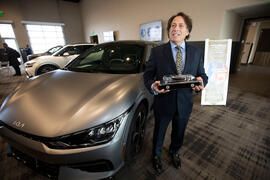
Kia's US COO, Steve Center, is something of a legend in the US car tradeAround a fifth of the Korean brand's volume in the US comes from a factory in Mexico
“God help you,” says Kia America COO Steve Center when asked what he thinks of the UK’s ZEV mandate, which forces car makers to sell a set proportion of their overall cars as EVs, regardless of demand.
“You can tell manufacturers what to make but you can’t tell consumers what to buy.”
We could probably say the same back to Center, who like all executives in the US this week will be braced for just what awaits them when Donald Trump returns to the White House.
Policies he has mooted include enormous tariffs on all cars imported into the US and a reversal of both buyer incentives and manufacturer subsidies for building EVs and battery factories in the US.
Center is diplomatic in not talking personalities or political parties yet says “it’s very difficult to stop a freight train” after “auto companies and consumers have all been motivated to change their production and their preferences”.
“A reversal in some of the regulations is going to do a lot of damage to a lot of businesses, because you’ve committed capital based on a certain set of assumptions,” he says.
The US market is a complex place to do business at the best of times, due to the vast scale of the place, different consumer preferences in different areas and different policies both between states and nationally.
“We’ve had different parts of the government regulating the same thing differently sometimes and regulating more things,” says Center.
“Then you have California steering from the rear. It’s very difficult to make long-term decisions when you’re investing capital in an environment where the rules are going to change every four years.”
California has the highest rate of EV adoption in the US, and some states have now followed it in introducing their own ZEV mandates “without consumer demand” to match.
Center continues: “Then there are some places where the populations are so sparse that they’re not creating enough CO2 – North Dakota, Montana. Leave them alone.”
The result of all this is that Kia is on “a consistent course to have two line-ups: internal combustion and fully electrified. They will sell at different rates in different parts of the country.”
Center is something of a legend in the US industry, having overseen Honda’s vast operations there for most of his career before switching to Kia two years ago. Record sales followed in 2023 - almost 750,000 - and in December the fi rm was on track to better that.
With a factory in Mexico providing around a fifth of Kia US’s volume, it “depends what and how [Trump] wants to tariff” as to how exposed Kia is to imminent policy changes.
“But,” says Center, “I’m a free-market person: the more you monkey with it, the more you create unintended consequences.”